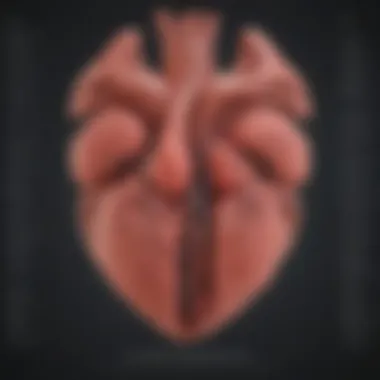Understanding Viral Cardiomyopathy Symptoms and Impact


Intro
Viral cardiomyopathy represents a critical intersection of virology and cardiology, focusing on the impact of viral infections on heart health. The heart muscle can become affected through a variety of viral agents, leading to significant symptoms that vary in intensity and duration. This section provides an overview of the relevance and necessity of understanding these symptoms in the wider context of cardiovascular health.
Viral infections, particularly those caused by viruses like enteroviruses or adenoviruses, can trigger an immune response that inadvertently harms cardiac tissue. Symptoms may range from mild fatigue to severe heart failure, making it vital for both healthcare professionals and patients to acknowledge their significance.
Understanding these symptoms not only aids in timely diagnosis but also facilitates appropriate treatment options, ultimately benefiting individual health outcomes and public health policies.
Research Highlights
Key Findings
Research into viral cardiomyopathy has unveiled several crucial insights into its symptomatology and pathophysiology. Key findings include:
- Symptom Variability: Symptoms can vary widely. Some patients may exhibit no symptoms at all, while others face acute heart failure.
- Chronic Implications: In some cases, viral cardiomyopathy can lead to long-term complications such as dilated cardiomyopathy.
- Diagnostic Challenges: Traditional diagnostic methods often fail to identify the condition early, underscoring a need for improved testing protocols.
"Early recognition of symptoms related to viral cardiomyopathy can significantly improve patient outcomes and reduce mortality rates."
Implications and Applications
- Clinical Guidelines: Enhancing the development of diagnostic and treatment guidelines for clinicians.
- Patient Education: Empowering patients with knowledge about potential symptoms to seek timely medical assistance.
- Public Health Strategies: Informing public health initiatives focused on preventing viral infections, particularly in vulnerable populations.
Methodology Overview
Research Design
The research design for studies on viral cardiomyopathy often involves a combination of observational and interventional studies. These studies observe patient outcomes and test various diagnostic methods and treatments to ascertain their effectiveness. Researchers typically focus on patient cohorts diagnosed with viral infections that impact heart function.
Experimental Procedures
Common experimental procedures include:
- Cardiac Imaging: Techniques like echocardiography or magnetic resonance imaging (MRI) to assess heart function.
- Biomarker Analysis: Blood tests to identify inflammation or viral presence that could indicate myocarditis.
- Longitudinal Studies: Monitoring patients over time to understand the progression of symptoms and long-term outcomes.
By compiling and analyzing data from these various methodologies, the medical community can better comprehend the intricate relationship between viral infections and heart health.
Prelude to Viral Cardiomyopathy
Viral cardiomyopathy is a critical area of study within cardiovascular disease. It encompasses a spectrum of heart muscle impairments resulting from viral infections. Understanding this condition is essential for accurate diagnosis and effective management. This section aims to lay the groundwork by defining the term and providing insights into its relevant epidemiological aspects.
Definition and Overview
Viral cardiomyopathy refers to heart muscle inflammation and dysfunction triggered by viral agents. This condition can occur after viral infections, primarily affecting the myocardium, which is vital for the heart's pumping ability. It often develops stealthily, leading to significant health consequences. Individuals may experience a range of symptoms, some of which may be overlooked until the disease progresses. The virus can initiate an immune response that, while aimed at eliminating the pathogen, can inadvertently lead to further myocardial damage.
Epidemiology
The epidemiology of viral cardiomyopathy highlights its prevalence and risk factors. It is estimated that viral infections are responsible for a notable percentage of dilated cardiomyopathy cases globally. Different viruses, such as Coxsackievirus B and adenoviruses, have been associated with this condition. The rates of occurrence can vary by geographical region and population demographics. Factors such as age, pre-existing health conditions, and genetic predisposition may also influence susceptibility.
Understanding these epidemiological trends is crucial for developing targeted public health strategies and improving patient outcomes.
In summarizing the importance of recognizing viral cardiomyopathy, it is clear that awareness can lead to prompt identification and treatment, which may ultimately improve long-term health results. The progression of our understanding will be discussed further in the following sections.
Understanding Viral Infections and Their Impact
Understanding the impact of viral infections is crucial in studying viral cardiomyopathy. This condition occurs as a result of viral infiltration leading to inflammation and damage to the cardiac muscle. Comprehending viral infections aids in the identification of the root causes that contribute to the development of various cardiac complications. It helps clinicians and researchers to target preventative measures and therapeutic strategies effectively, thus limiting the progression of viral-associated diseases.
Mechanisms of Viral Entry
Viruses use various mechanisms to gain entry into the host cells, which is essential for the onset of infection. The first step typically involves attachment to the surface of the cardiac cells. This is achieved through specific viral surface proteins that bind to receptors on the cells. For instance, the Coxsackievirus, a common viral offender in cardiomyopathy, utilizes lipid rafts to facilitate its entry.
Once attached, the virus can enter the cell through direct fusion with the cell membrane or via endocytosis, where the cell engulfs the virus in a vesicle. After entering the cell, the virus releases its genetic material into the host cell's cytoplasm, hijacking the host's cellular machinery to replicate. This process can lead to direct cellular toxicity, but often, it also stimulates an immune response, resulting in further damage.
"The host's immune response is a double-edged sword, as it can destroy the viral particles while also causing inflammation that can harm cardiac tissues."


Types of Viruses Associated with Cardiomyopathy
Several viruses have been linked to the development of viral cardiomyopathy. Understanding these viral types is key in identifying risk factors and treatment options.
- Coxsackievirus B: This is the most frequently implicated virus in viral myocarditis. Its affinity for cardiac tissues makes it a primary concern.
- Adenovirus: This virus can cause respiratory symptoms but can also affect the myocardium, leading to inflammation and cardiomyopathy.
- Parvovirus B19: Known for causing fifth disease in children, it also affects adults and is linked to cardiac complications.
- Influenza virus: Though primarily a respiratory virus, influenza can precipitate myocarditis and subsequent cardiomyopathy, particularly in patients with pre-existing cardiovascular conditions.
- Human Immunodeficiency Virus (HIV): It can lead to cardiac problems indirectly through the progression of HIV infection, which affects overall immune health.
Each of these viruses has distinct entry mechanisms and can provoke a variety of responses from the immune system. By identifying the specific virus involved, healthcare professionals can tailor more effective treatment plans and improve patient outcomes.
Clinical Symptoms of Viral Cardiomyopathy
Viral cardiomyopathy can manifest through a range of clinical symptoms, which are critical for diagnosis and management. Understanding these symptoms is essential for effective treatment strategies and improving patient outcomes. They often indicate an underlying viral infection impacting heart function. Recognizing these symptoms early can prevent severe complications, making them key observations in clinical practice.
Common Symptoms
Chest Pain
Chest pain is one of the hallmark symptoms of viral cardiomyopathy. It often signals myocardial inflammation and irritation. This symptom can vary in intensity. It may present as sharp, stabbing sensations or a dull ache. Recognizing chest pain is beneficial as it prompts immediate medical evaluation. Early intervention can be crucial.
The unique feature of chest pain in viral cardiomyopathy is its potential link to heart muscle damage. Patients commonly report this symptom during acute phases of the illness. Such pain can be misinterpreted as heart attack, leading to necessary tests. However, misdiagnosis can occur since chest pain is not exclusive to cardiomyopathy.
Shortness of Breath
Shortness of breath often accompanies viral cardiomyopathy. It is related to the heart's diminished capacity to pump blood efficiently. Patients might experience gradual or sudden onset of breathlessness, especially during exertion. This symptom indicates significant cardiac dysfunction and requires assessment.
The key characteristic of shortness of breath is its direct correlation with heart performance. It is a beneficial symptom to monitor, as increasing severity may reflect worsening heart condition. Patients often report fatigue as well, but distinguishing these symptoms can aid in proper evaluation.
Fatigue
Fatigue is another prevalent symptom in viral cardiomyopathy. It results from reduced circulation and oxygen supply due to impaired myocardial function. Patients may feel unusually tired even with minimal activity. This symptom has significant implications for daily living and overall quality of life.
The unique feature of fatigue is that it can be nonspecific. While common in many health conditions, its presence in conjunction with others can raise suspicion of viral cardiomyopathy. Understanding how fatigue affects patients can aid in tailored management strategies.
Severe Symptoms
Arrhythmias
Arrhythmias are serious symptoms that can arise in patients with viral cardiomyopathy. They indicate irregular heart rhythms due to electrical disturbances in the heart. The development of arrhythmias can lead to significant health risks, including sudden cardiac arrest. Thus, recognition is critical.
The key aspect of arrhythmias is their varied presentation. They can be benign or life-threatening. Their management often involves medications or procedures, emphasizing the importance of monitoring heart rhythms in affected individuals.
Syncope
Syncope, or fainting, can occur as a symptom in severe cases of viral cardiomyopathy. It is critical because it may reflect impaired cerebral circulation due to insufficient heart function. This could indicate a life-threatening situation requiring urgent examination.
A key characteristic of syncope is its sudden onset, often without prior warning. This symptom demands thorough evaluation to rule out underlying cardiac issues. Understanding its connection to viral cardiomyopathy can aid in effective risk management strategies.
Heart Failure
Heart failure represents a culmination of symptoms in severe viral cardiomyopathy. It arises when the heart's capacity to pump blood becomes compromised. Symptoms can include both physical and psychological impacts, significantly affecting quality of life.
The unique feature of heart failure is its chronic nature. Management often requires long-term strategies, including lifestyle changes and medications. Recognizing heart failure as a symptom is integral to developing a comprehensive treatment plan.
Understanding the clinical symptoms of viral cardiomyopathy is imperative for clinicians. Early detection can lead to timely interventions.
Diagnosis of Viral Cardiomyopathy
The diagnosis of viral cardiomyopathy is crucial. Understanding the symptoms plays a significant role in determining the underlying cause and guiding treatment options. Since the symptoms can vary widely, ranging from mild to severe, proper diagnosis is necessary to manage this serious condition effectively. Early detection allows for timely interventions, which can mitigate risks and improve outcomes for patients. Furthermore, distinguishing viral cardiomyopathy from other types of heart diseases is critical, as management strategies will differ based on the underlying factors.
Clinical Evaluation
Clinical evaluation involves a thorough patient history and physical examination. Physicians take detailed accounts of the patient's symptoms, illness onset, and any recent infections. Symptoms such as fatigue, chest pain, and shortness of breath provide hints about possible heart involvement. Physicians look for signs of heart failure or arrhythmias during the examination.
Family medical histories may also help identify genetic predispositions or inherited conditions. A holistic approach to clinical evaluation is essential for tailoring the right diagnostics and subsequent treatment plan.


Imaging Techniques
Echocardiography
Echocardiography is a non-invasive imaging technique vital for diagnosing viral cardiomyopathy. This method uses sound waves to create moving images of the heart. It helps assess heart size, shape, and function. One key characteristic of echocardiography is its ability to evaluate ventricular function and identify any structural abnormalities. It is often the first imaging choice for clinicians due to its accessibility and real-time findings.
The unique feature of echocardiography is its functional assessment capability without requiring radiation. However, it may have limitations in detecting certain myocardial changes.
Cardiac MRI
Cardiac MRI provides a detailed evaluation of the heart muscle, offering insights that echocardiography may not capture. This imaging technique has strong resolution and allows for the assessment of myocardial tissue characteristics. Cardiac MRI is beneficial for identifying areas of inflammation or necrosis within the heart muscle.
Its unique feature lies in the ability to quantify scar tissue. While this offers profound diagnostic information, cardiac MRI may be less accessible due to cost and the need for specialized equipment.
Laboratory Tests
Blood Tests
Blood tests can reveal crucial information about viral infections and heart damage. Certain biomarkers, such as troponins and natriuretic peptides, are often elevated in patients with cardiomyopathy. These biomarkers help in gauging the level of heart stress and injury.
The advantage of blood tests is that they are relatively simple, quick, and can be performed in standard lab settings. However, they may not always pinpoint viral cardiomyopathy specifically.
Viral Culture
Viral culture is a technique used to detect the presence of viruses in the bloodstream. It plays a crucial role in confirming the specific viral agents responsible for the cardiomyopathy. This lab test can help clarify the pathophysiology behind the heart's impairment.
The notable advantage is that it can provide direct evidence of viral infection. However, viral culture is time-intensive and may not yield results swiftly. It also requires specialized facilities, which can limit accessibility.
Proper diagnosis is essential for effective management of viral cardiomyopathy.
In summary, a mix of clinical evaluations, advanced imaging techniques, and laboratory tests are key components in diagnosing viral cardiomyopathy. Early and accurate diagnosis is essential to directing appropriate treatment and enhancing patient prognoses.
Pathophysiology of Viral Cardiomyopathy
The pathophysiology of viral cardiomyopathy is a crucial aspect of understanding how viral infections impact the heart muscle. This section elucidates the complex interplay between viral agents and host responses, which can culminate in significant cardiac dysfunction. Comprehending the underlying mechanisms provides insight into potential treatment avenues and preventive measures, making it vital for those studying or working in cardiovascular health.
Host Immune Response
When a virus infects the heart, it triggers an immune response aimed at eradicating the pathogen. This response involves various immune cells, including T cells and macrophages, and the release of cytokines. While these reactions are necessary to fight off the viral invasion, they may inadvertently contribute to myocardial damage. Inflammation becomes a double-edged sword; excessive inflammation can lead to scar formation and leave the heart less capable of functioning properly.
Factors influencing the degree of immune response include the type of virus, genetic predispositions of the host, and pre-existing health conditions. A robust immune response may help clear the virus, but it can also worsen tissue damage. In this context, understanding how to modulate the immune response becomes essential.
Myocardial Damage Mechanisms
The interaction between viral particles and cardiac cells can lead to direct and indirect damage of the myocardium. The direct effect occurs when viruses invade heart muscle cells, disrupting their normal function. In cases where the virus can replicate within these cells, it may lead to cell death and the subsequent release of inflammatory mediators that exacerbate tissue damage.
Indirect damage often relates to the inflammatory response mentioned earlier. Once the immune system responds vigorously, a cascade of biochemical signals ensues, which can generate reactive oxygen species. These molecules can impair cardiac cell function, resulting in apoptosis, fibrosis, and eventual heart dysfunction.
Additional pathways of damage also exist, such as the effects of viral proteins. Certain viral proteins can interfere with cellular signaling pathways, further complicating the myocardial health. Through all these mechanisms, the ultimate outcome may range from mild cardiac impairment to severe heart failure, necessitating a comprehensive understanding of the various processes involved in viral cardiomyopathy.
"Understanding the pathophysiology provides a foundation for effective management and potential intervention strategies in viral cardiomyopathy."
Management and Treatment Strategies
The management and treatment of viral cardiomyopathy are crucial in addressing the symptoms and improving the quality of life for affected individuals. Effective strategies can significantly influence the recovery process, making early intervention and comprehensive care paramount. Understanding the range of treatment options allows healthcare providers to tailor therapies to specific patient needs, which can lead to better outcomes.
Medical Management
Antiviral Therapy
Antiviral therapy is a vital approach in treating viral cardiomyopathy. This strategy aims to directly target the underlying viral infections causing the condition. The key characteristic of antiviral therapy is its ability to potentially reduce viral load, aiming to alleviate the inflammation and damage caused to heart tissue. Antiviral agents, such as acyclovir or ribavirin, can play a significant role in treating infections like enteroviruses or HIV, which have been linked to heart issues.
One unique feature of antiviral therapy is its focus on eradicating the viral agent. This can offer a distinct advantage, especially in cases where the virus is the primary driver of myocardial damage. However, the disadvantages include limited efficacy against certain viruses and the potential for adverse effects associated with the medications.


Symptomatic Treatment
Symptomatic treatment focuses on alleviating the symptoms associated with viral cardiomyopathy, thereby improving patient comfort and functionality. This aspect of management is crucial as it addresses the immediate challenges faced by individuals, such as shortness of breath and fatigue. A key characteristic of symptomatic treatment is its use of medications like diuretics, beta-blockers, or ACE inhibitors to ease the burden on the heart.
A unique feature of symptomatic treatment is its adaptability to a patient’s current condition. Physicians can modify treatment plans based on ongoing assessments, which makes it flexible and responsive. However, while symptomatic management improves quality of life, it does not directly address the root cause, which remains a limitation in the overall treatment strategy.
Potential for Heart Transplant
In severe cases of viral cardiomyopathy, when the heart's function is irreparably compromised, heart transplant may present the only viable long-term solution. The potential for heart transplant illustrates the serious nature of this condition. Transplantation offers a chance for recovery and enhanced life expectancy for individuals whose hearts cannot recover through other treatment modalities. The evaluation for a transplant involves several factors, including the patient’s overall health, the degree of heart failure, and response to previous treatments.
Prognosis and Long-Term Outcomes
When examining viral cardiomyopathy, it is crucial to consider prognosis and long-term outcomes. Understanding these aspects not only offers insights into individual patient management but also informs broader public health strategies. A favorable prognosis can significantly improve patient quality of life and may aid in better resource allocation within healthcare settings.
In this section, we will discuss the factors influencing prognosis and the importance of long-term surveys and research in unraveling the complexities of viral cardiomyopathy. Both clinical and non-clinical elements play vital roles in determining outcomes for affected individuals.
Factors Influencing Prognosis
Several key factors can affect the prognosis of patients diagnosed with viral cardiomyopathy. These include:
- Age at Diagnosis: Younger patients often exhibit better outcomes compared to older individuals. This may be due to greater resilience and a more robust immune response in younger bodies.
- Type of Virus: The specific virus implicated in the cardiomyopathy can have varying effects. For instance, enteroviruses and adenoviruses are more commonly associated with poor outcomes compared to others.
- Severity of Symptoms: The initial severity of heart failure can indicate the likelihood of recovery. Severe symptoms at presentation may correlate with a more guarded prognosis.
- Comorbid Conditions: Presence of other health issues, such as diabetes or hypertension, can complicate management and worsen outcomes.
- Response to Treatment: Early initiation of appropriate treatment plays a significant role in recovery. Patients who respond well to antiviral therapies tend to have better long-term outcomes.
Understanding these factors allows clinicians to tailor treatment plans and set realistic expectations for patients and their families.
Long-Term Surveys and Research
Long-term surveys and research are vital to appreciating the evolving landscape of viral cardiomyopathy outcomes.
Such studies can reveal important trends:
- Disease Progression: Long-term data helps track how symptoms and heart function change over time in individual patients.
- Treatment Effectiveness: Research can assess the long-term effectiveness of antiviral therapies and other management strategies.
- Quality of Life Measures: Longitudinal studies often include quality-of-life assessments, providing insights into the true impact of the disease beyond clinical parameters.
- Population-Level Health: Analyzing data across a broad population helps public health officials identify patterns, allocate resources effectively, and develop preventive strategies.
As such, continuous research into viral cardiomyopathy not only aids individual patients but also enhances our understanding of cardiovascular diseases as a whole. It assists in painting a comprehensive picture of the community and global burden associated with viral infections impacting heart health.
"Prognosis in viral cardiomyopathy is shaped by a combination of clinical factors, making individualized assessment essential for effective management."
In summary, understanding prognosis and long-term outcomes in viral cardiomyopathy requires a detailed exploration of various influencing factors. Ongoing research and population studies remain crucial for advancing strategies aimed at improving patient outcomes and public health interventions.
Preventive Measures
Preventive measures are crucial in managing the risk of viral cardiomyopathy. This section provides insights into strategies that can help mitigate the spread of viruses associated with heart muscle damage. Understanding these measures is necessary for both individuals and health authorities to reduce the incidence of this condition.
Vaccination Strategies
Vaccination serves as a primary line of defense against many viral infections. For viral cardiomyopathy, vaccines targeting specific viruses like influenza and enteroviruses are vital. These vaccinations aim to create immunity, thereby reducing the likelihood of viral infections that could lead to heart complications.
- Influenza Vaccine: Annual flu vaccines are recommended to decrease the risk associated with influenza-related myocarditis.
- Vaccines for Enteroviruses: Research is ongoing into vaccines that can prevent infections like Coxsackievirus B, which have been linked to viral cardiomyopathy.
Successful vaccination campaigns can help control outbreaks, especially in vulnerable populations, such as people with pre-existing health issues. Vaccination not only protects individuals but also provides herd immunity, indirectly safeguarding those who are unable to get vaccinated.
Public Health Initiatives
Public health initiatives play a crucial role in preventing viral infections that could lead to cardiomyopathy. These initiatives involve a combination of education, outreach, and monitoring. Key elements of effective public health strategies include:
- Awareness Campaigns: Raising awareness about the symptoms of viral infections and their connections to heart diseases can prompt earlier medical intervention.
- Promoting Hygiene Practices: Encouraging handwashing and safe food preparation can reduce transmission rates of viruses.
- Surveillance and Monitoring: Ongoing monitoring of viral infections in the community allows for quick responses to outbreaks.
Effective preventive measures can significantly lower the risk of developing viral cardiomyopathy. Integrating vaccination efforts with public health initiatives enhances the overall response to viral infections affecting the heart.
End
The conclusion section of the article serves as a capstone to the complex topic of viral cardiomyopathy. It is crucial to synthesize the information presented throughout the article to reinforce understanding and relevance.
In summary, viral cardiomyopathy stands as a significant medical condition that can lead to serious cardiac complications. The symptoms vary considerably among patients, making personalized diagnosis and management essential. By discussing the potential symptoms, diagnostic techniques, and treatment options, the article articulates the multifaceted nature of this disease.
It is important to recognize that early detection can greatly affect outcomes. Understanding and identifying the various symptoms can lead to timely interventions, ultimately enhancing the quality of life for affected individuals.
Healthcare professionals, researchers, and students must grasp the implications of viral cardiomyopathy. This condition is not just about individual health concerns; it has broader public health implications. The interaction between viral infections and heart health requires attention to support ongoing medical research and community awareness. Educating the public may assist in prevention strategies, especially concerning high-risk populations.
Lastly, the future directions in research highlighted in this article will pave the way for innovations in treatment approaches. Overall, the conclusions drawn from this article underscore the necessity for continued investigation into viral cardiomyopathy and its impacts.



